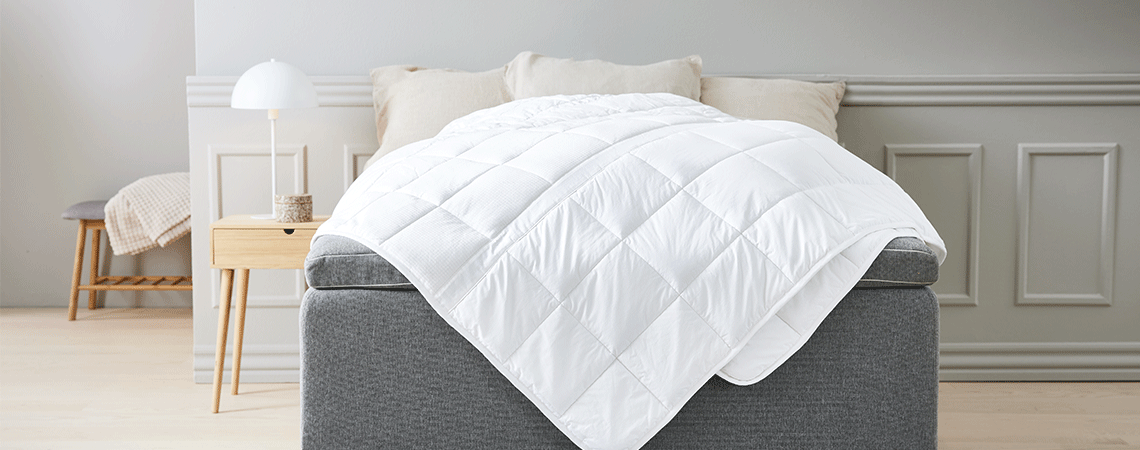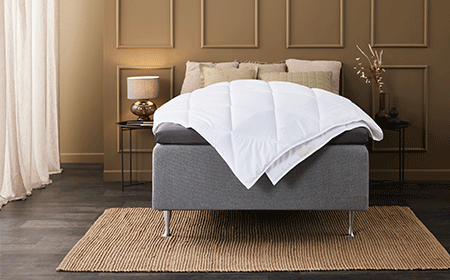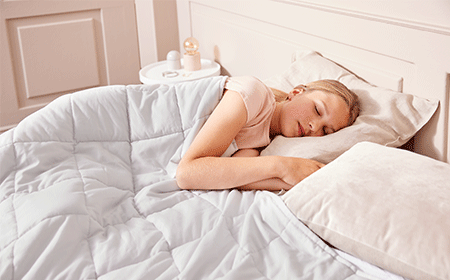Answering the question of when it is time for you to replace your duvet can be difficult, as there are many factors that influence the longevity of your duvet – however as a general guideline, you should replace your duvet every five to ten years.
The main factor when it comes to the longevity of your new duvet is its quality. This is the case for all types of duvets, no matter if they have natural filling or fibre filling. Other important factors that impact the longevity of your duvet include:
- How well you take care of your duvet in your everyday
- Your sleeping situation and habits – if you toss and turn or sweat a lot during the night, it may wear out the duvet at a faster pace
- How often you air out or wash your duvet – if you do not regularly do this, or if you use the duvet again before it has dried off after a wash, the duvet’s lifespan will also be shortened
Regardless of the quality of your duvet and how well you care for it, a 5–10-year lifespan is a generally realistic timeline for a PLUS or GOLD duvet. Once your duvet approaches the 10-year mark, it may likely be time for you to consider replacing it with a new duvet.
How often should you replace your duvet?
If you’re uncertain about when it’s time for you to replace your duvet, you should pay attention to and closely consider the following four indicators:
- Filling volume
Check if the filling maintains its original volume, and if the duvet feels as plump as when you first bought it. - Clumped filling
Ensure that the filling is evenly distributed throughout the duvet and not clumped together in certain areas. - Duvet lining
Watch out for small holes in the fabric, as they can cause filling to escape, especially as they grow in size or number. - Duvet appearance
If your duvet has clearly visible stains or discolouration that won’t wash out, it's time to replace it.
When your duvet begins to show clear signs of wear and tear, it's not just a matter of appearance. As its condition deteriorates, so does its functionality. For example, if the filling starts clumping in certain areas, it compromises the duvet's insulation properties, resulting in reduced warmth compared to when it was new. In such a state, a seemingly cool night can quickly become uncomfortably cold, largely due to the duvet's compromised condition.
If you want to know all about how to choose the perfect duvet, check out our ultimate guide: Which duvet should you choose?
What can you do to improve the durability of your duvet?
Proper care can significantly extend the lifespan of your duvet, regardless of its quality. By following these steps, you can maintain its durability and preserve its volume for longer:
- Daily maintenance
Shake your duvet thoroughly but very gently every day to maintain the resilience of its filling. Avoid vacuuming or pounding on it, as this easily can damage the filling. - Air circulation
Allow your duvet to air out daily, avoiding immediately covering it with a bedspread after waking up to prevent any potential issues with moisture. For optimal freshness, if it’s an option for you, hang it outside to dry out in the breeze a few times a week. - Reviving the filling
Over time, the filling may become compressed. To expand it again, place the duvet in the dryer with a couple of dryer balls, following the instructions on the washing label. - Regular washing
If your duvet is washable – refer to the washing label on your own duvet – wash it two to four times a year, carefully following the instructions on the label. Ensure it is completely dry before returning it to your bed. To confirm dryness, weigh the duvet before washing and compare it to its post-drying weight to ensure all moisture is released.
What is the connection between a duvet’s quality and its lifespan?
The frequency with which you should replace your duvet depends partly on its quality. Higher-quality materials and construction enhance durability, while your everyday maintenance habits, such as how often you gently shake or pat the filling and thoroughly air it out, also play a role.
The quality of a duvet is determined by the raw materials it's made of. Generally, investing more in a duvet means purchasing materials that offer greater durability compared to cheaper alternatives. Improved durability is a key benefit of higher quality.
In JYSK, we prioritise the quality of our duvets. We're confident that our materials can withstand a decade of normal usage, as evidenced by our extended warranties for JYSK duvets for two of our quality ranges:
- PLUS duvets: 5-year guarantee for both natural and fibre duvets
- GOLD duvets: 10-year guarantee for both natural and fibre duvets
Learn more about JYSK’s quality ranges and the price levels of duvets across our assortment.




